Scottish Schools Adolescent Lifestyle and Substance Use Survey 2015: mental wellbeing report
Report on the mental wellbeing of adolescents in Scotland.
This document is part of a collection
2 Emotional and behavioural problems and mental wellbeing indicators
Strengths and Difficulties Questionnaire ( SDQ) Score
Just over two thirds (69%) of all pupils had a normal total difficulties score, while 16% had a borderline score and a further 15% had an abnormal score.
There has not been a great deal of change in total difficulties score between 2006 and 2010. However, there has been a slight decrease in the percentage of pupils with a normal score between 2010 and 2015 (from 75% in 2010 to 69% in 2015) and a slight increase in the percentage of pupils with an abnormal score (from 11% in 2010 to 15% in 2015) (Figure 2.1).
Figure 2.1: Total difficulties score (2006-2015)
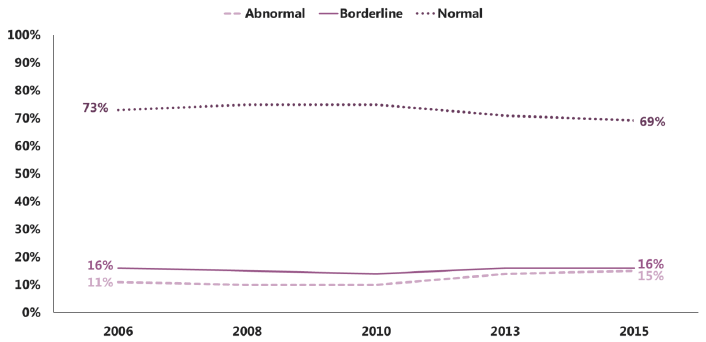
Base: See Appendix A
At first glance, this would suggest that the proportion of pupils with emotional and behavioural problems has changed little over the past ten years. However, this overall picture hides a more complicated pattern that emerged when the data was broken down by age and gender.
As can be seen in Figure 2.2, there is a considerable gap between 15 year old girls and all other demographic groups. This gap increased between 2010 and 2013 but there was no further increase between 2013 and 2015. The only change between 2013 and 2015 was a slight increase in the proportion of 15 year old boys with a borderline or abnormal score (Figure 2.2).
Figure 2.2: Trends in total difficulties scores by gender and age (% borderline or abnormal score) (2006-2015)
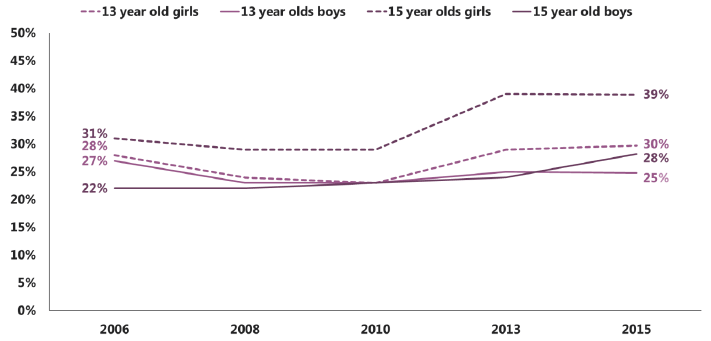
Base: See Appendix A
Individual SDQ Scales
The total difficulties score gives us an overview of how emotional and behavioural problems among young people in Scotland have changed over the past nine years. However, it covers four very different issues: hyperactivity, emotional problems, conduct problems and peer problems. These four scales did not show a consistent pattern of change. Not included in the total difficulties score is the pro-social scale. This scale is a measure of positive behaviour in young people and, as such, is measured in terms of the proportion of pupils with a normal score, rather than the proportion with a borderline or abnormal score. Therefore, it is not included in Figure 2.3 below.
In 2015, pupils were most likely to have a borderline or abnormal score on the hyperactivity scale (31%). This was followed by the emotion scale (26%), conduct scale (24%), and peer problems scale (22%) (Figure 2.3).
Hyperactivity was the most common self-reported emotional and behavioural problem and this has remained the case over time, although there has been a slight decrease in the proportion with a borderline or abnormal score between 2006 and 2015.
There was a greater amount of change among the other three scales. The proportion of pupils with a borderline or abnormal score on the conduct scale decreased between 2006 and 2015 (from 32% in 2006 to 22% in 2015). In contrast, the proportion of pupils with a borderline or abnormal score on the emotional problems scale (from 16% in 2006 to 26% in 2015), and to a lesser extent the peer problems scale (from 14% in 2006 to 22% in 2015), increased between 2006 and 2015 (Figure 2.3).
Figure 2.3: Individual SDQ scales between 2006 and 2015 (% borderline or abnormal score)
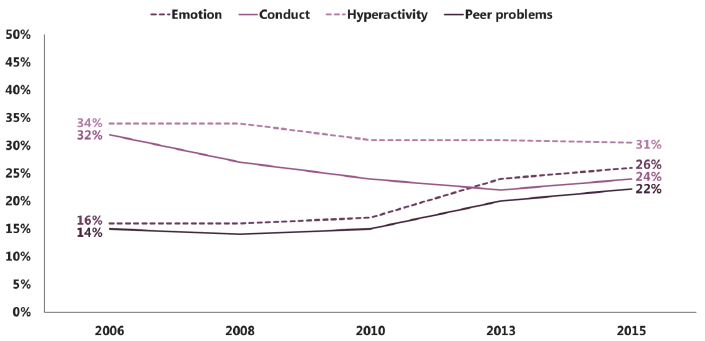
Base: See Appendix A
Emotional Problems
Overall in 2015, 74% of pupils had a normal emotional problems score. 18% had an abnormal score while 8% had a borderline score.
Girls were considerably more likely than boys to have a borderline or abnormal emotional problems score, showing the same pattern as the total difficulties scores but to a much greater extent. Furthermore, 15 year old girls were much more likely than 13 year old girls to have a borderline or abnormal score. While the greatest change among 15 year old girls was between 2010 and 2013 there was a further increase in the proportion with a borderline or abnormal score from 41% to 44% between 2013 and 2015. There was no change between 2013 and 2015 among 13 or 15 year old boys.
Figure 2.4: Trends in emotions SDQ scores by gender and age (% borderline or abnormal score) (2006-2015)
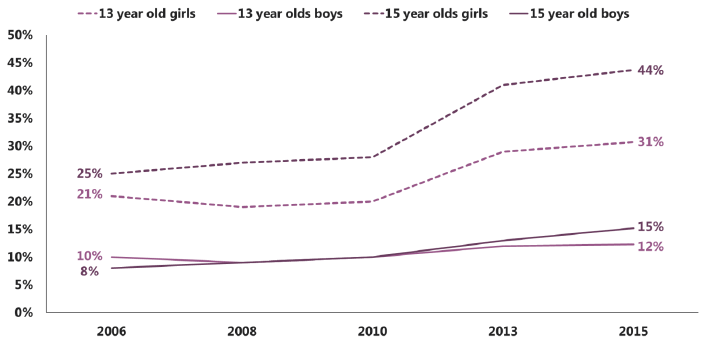
Base: See Appendix A
Individual items on the emotional problems scale
Given the marked increase in the proportion of 15 year old girls, and to a lesser extent 13 year old girls, with a borderline or abnormal emotional problems score, further analysis was conducted to explore which of the individual items contributed the most to the change. The individual statements included in the emotional problems scale were:
- I worry a lot
- I am nervous in new situations. I easily lose confidence
- I get a lot of headaches, stomach-aches or sickness
- I have many fears, I am easily scared
- I am often unhappy, down-hearted or tearful.
Girls were most likely to agree that it was certainly true that they 'worry a lot' or that they 'easily lose confidence'. 15 year old girls were more likely than 13 year old girls to say that each of the statements were certainly true with the exception of 'I have many fears; I am easily scared' (Figure 2.5).
Figure 2.5: Individual emotional problems items among girls, by age (% borderline or abnormal score) (2006-2015)
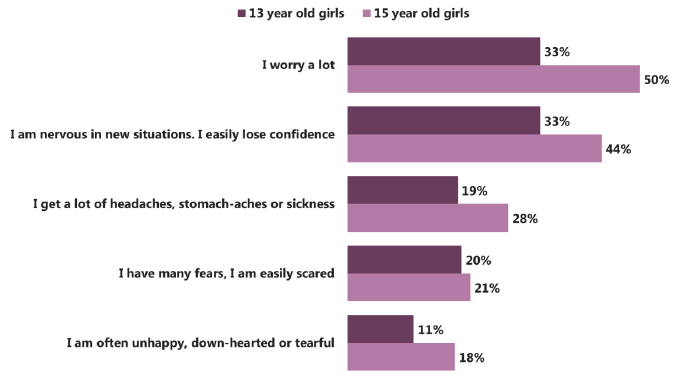
Base (2015): 13 year old girls (6,014) 15 year old girls (5,207)
'I worry a lot' and 'I am nervous in new situations. I easily lose confidence' were also the statements that showed the greatest change over time. As Figure 2.6 shows, the proportion of 15 year old girls saying it was certainly true that they worry a lot increased considerably between 2010 and 2013 (from 31% in 2010 to 50% in 2015).
A similar trend emerged among 13 year old girls: 19% said it was certainly true they worried a lot in 2010, compared with 33% in 2015.
Figure 2.6: Trends in emotional SDQ questions for 15 year old girls (2006-2015) - 'I worry
a lot'
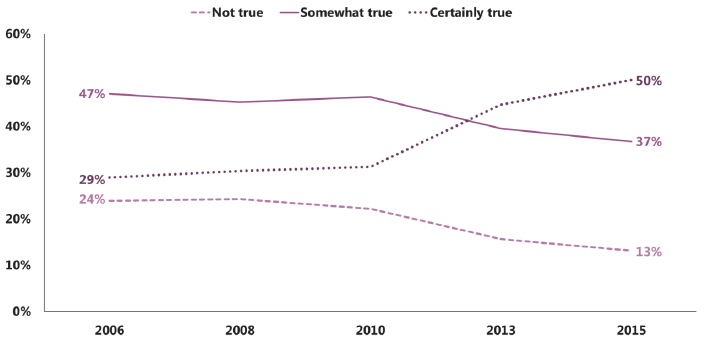
Base: See Appendix A
The same trend appeared for 'I am nervous in new situations. I easily lose confidence'. Among 15 year old girls, the proportion who said that this statement was certainly true had increased from 31% in 2006 to 44% in 2015.
Figure 2.7: Trends in emotional SDQ questions for 15 year old girls (2006-2015) - 'I am nervous in new situations. I easily lose confidence'
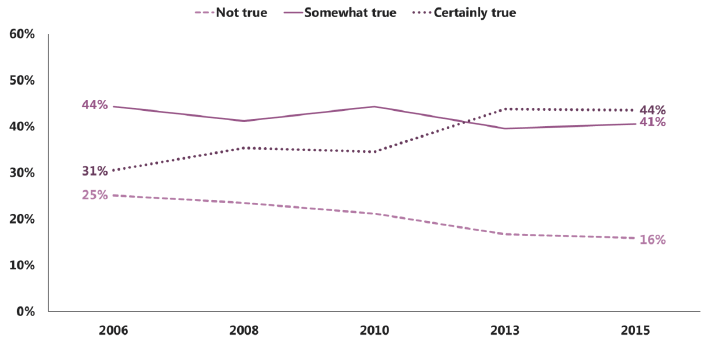
Base: See Appendix A
Conduct Problems
Three quarters (76%) of all pupils had a normal score on the conduct problems scale. 15% of pupils had an abnormal score, while 9% had a borderline score.
Boys were more likely than girls to have a borderline or abnormal score on the conduct problems scale: 28% of 15 year old boys and 27% of 13 year old boys had borderline or abnormal conduct score, compared with 22% of 15 year old girls and 20% of 13 year old girls (Figure 2.8).
Among all pupils, the proportion who had a borderline or abnormal score on the conduct scale decreased between 2006 and 2013. However, between 2013 and 2015 there was an increase in the proportion of 15 year old boys and 13 year old girls who had a borderline or abnormal conduct score (Figure 2.8).
Figure 2.8: Trends in conduct SDQ scores by gender and age (% borderline or abnormal score) (2006-2015)
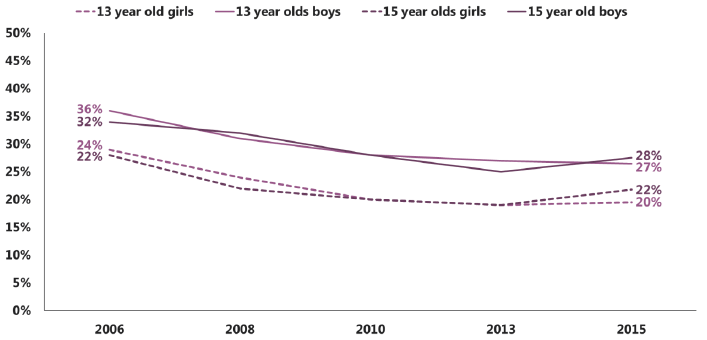
Base: See Appendix A
Individual items on the conduct problems scale
After decreasing steadily for a number of years, the proportion of 15 year old boys scoring borderline or abnormal scores on the conduct SDQ questions increased (from 25% to 28%). For this reason, further analysis was conducted to explore which of the individual items contributed the most to the change. The individual statements included in the conduct problems scale were:
- I usually do as I am told
- I get very angry and often lose my temper
- I am often accused of lying or cheating
- I take things that are not mine from home, school or elsewhere
- I fight a lot. I can make other people do what I want
The greatest change in the individual items that make up the conduct problems scale was an increase in the proportion of 15 year old boys who said that they fought [11] a lot. Between 2013 and 2015, the proportion of 15 year old boys saying that it was not true that they fought a lot decreased from 81% to 77%, while those saying that it was somewhat true increased from 16% to 18%, and those saying it was certainly true increased from 3% to 5% (Figure 2.9).
Figure 2.9: Trends in conduct problems SDQ questions for 15 year old boys (2006-2015) - 'I fight a lot. I can make other people do what I want'
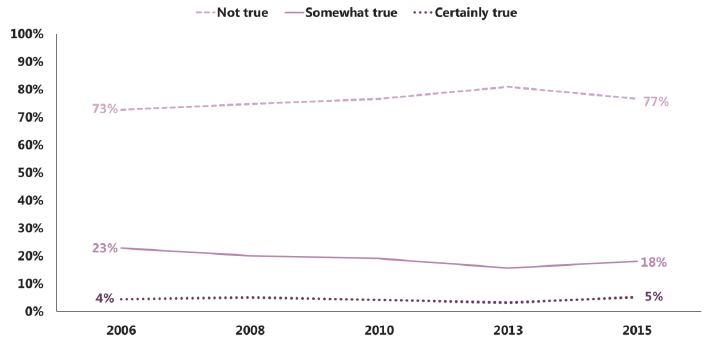
Base: See Appendix A
Hyperactivity
Seven in ten pupils (70%) had a normal score on the hyperactivity scale. 19% of pupils had an abnormal score, while 12% had a borderline score.
Since 2013, the proportion of 15 year old girls scoring borderline or abnormal scores has decreased slightly (from 36% to 34%) continuing a declining trend from 39% in 2006. Perhaps surprisingly, 15 year old girls were more likely than 15 year old boys to have a borderline or abnormal hyperactivity score (Figure 2.10).
A greater proportion of 15 year old girls had a borderline or abnormal scores than 13 year old girls (34%, compared with 28%). However, there was no difference between 13 and 15 year old boys, with 30% of 15 year old boys, and 29% of 13 year old boys scoring a borderline or abnormal score (Figure 2.10).
Figure 2.10: Trends in hyperactivity SDQ scores by gender and age (% borderline or abnormal score) (2006-2015)
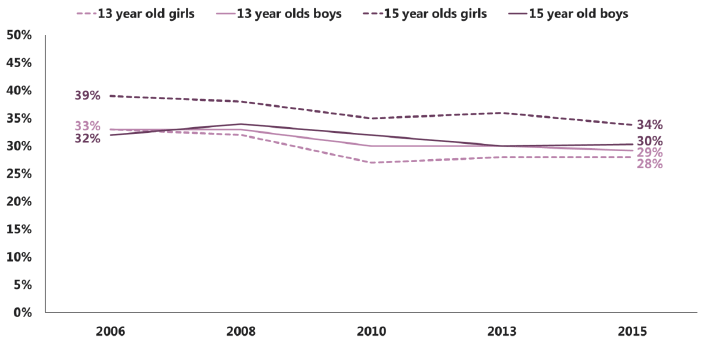
Base: See Appendix A
Peer Problems
Overall, 78% of pupils had a normal SDQ peer problems score, suggesting it was the emotional and behavioural problem pupils were least likely to have trouble with. 16% of pupils had an abnormal score, while 6% had a borderline score.
Boys were more likely than girls to have a borderline or abnormal score on the peer problems scale; this was true for both age groups.
Across all groups, with the exception of 15 year old girls, the proportion who had a borderline or abnormal scores increased between 2013 and 2015 (Figure 2.11).
Figure 2.11: Trends in peer problems SDQ scores by gender and age (% borderline or abnormal score) (2006-2015)
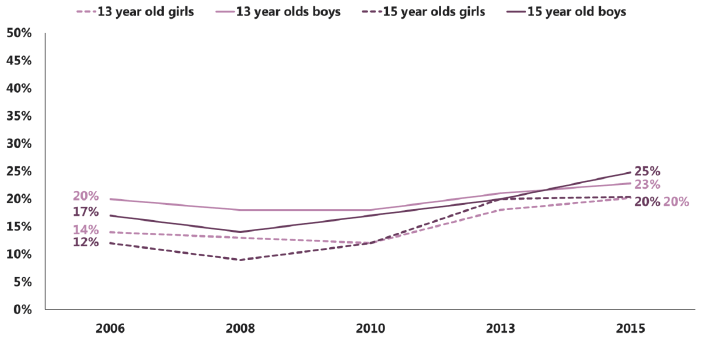
Base: See Appendix A
Individual items on the peer problems scale
Between 2013 and 2015, 15 year old boys experiencing peer problems - those scoring borderline or abnormal scores on the peer problems questions - increased from 20% to 25%. Therefore, further analysis was conducted to explore which of the individual items contributed the most to the change. The individual statements included in the peer problems scale were:
- I have one good friend or more
- Other people my age generally like me
- I get on better with adults than with people my own age
- I am usually on my own. I generally play alone or keep to myself
- Other children or young people pick on me or bully me
The largest change for 15 year old boys among the individual items on the peer problems scale was in relation to 'I am usually on my own. I generally play alone or keep to myself'.
The proportion of 15 year old boys saying that it was untrue that they were usually on their own, decreased from 65% to 62% between 2013 and 2015, while those saying it was certainly true increased from 6% to 10% (Figure 2.12).
Figure 2.12: Trends in peer problems SDQ questions for 15 year old boys (2006-20150 - 'I am usually on my own. I generally play alone or keep to myself'
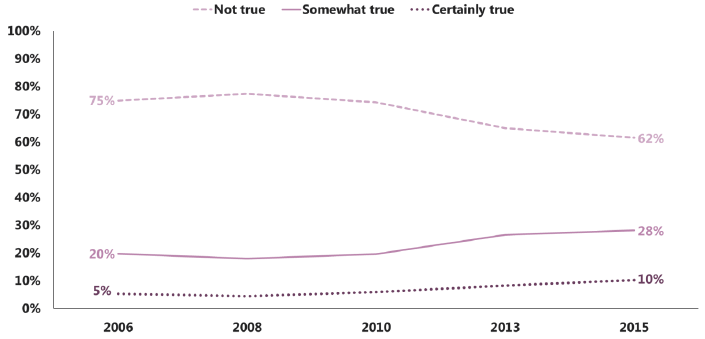
Base: See Appendix A
Pro-social score
The pro-social score on the SDQ is a measure of positive behaviour among young people, usually in terms of their behaviour towards others. Instead of looking at the proportion of pupils with a borderline or abnormal behaviour, it is usual to look at the proportion of pupils with a normal score on this scale.
Three quarters of all pupils (75%) had a normal score on the pro-social scale in 2015, while 12% had a borderline score and 13% had an abnormal score.
The percentage of pupils with a normal score has slowly increased since 2006. In 2006, 68% of pupils had a normal score, compared with 75% in 2013. Since 2013 there has been no further change (Figure 2.13).
Girls were more likely than boys to have a normal score on the pro-social scale. Since 2013, the proportion of girls with a normal score has decreased slightly. The percentage of boys with normal scores has increased from 2006. In particular, 13 year old boys scores have increased considerably since 2006 from 59% in 2006 to 72% in 2015 (Figure 2.13).
Figure 2.13: Trends in pro-social SDQ scores by gender and age (% normal score) (2006-2015)
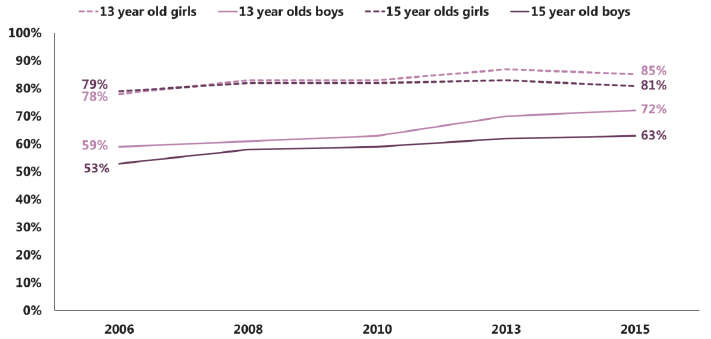
Base: See Appendix A
Individual items on the pro-social scale
Between 2010 and 2015, 13 year old boys exhibiting pro-social behaviour - those scoring normal scores on the pro-social questions - increased from 63% to 72%. Therefore, further analysis was conducted to explore which of the individual items contributed the most to the change. The individual statements included in the pro-social scale were:
- I try to be nice to other people
- I usually share with others
- I am helpful if someone is hurt, upset or feeling ill
- I am kind to younger children
- I often volunteer to help others
The largest change in the individual items that make up the pro-social scale was to 'I try to be nice to other people'. The proportion of 13 year old boys who said that this was 'certainly true' increased markedly between 2010 and 2015 (from 47% in 2010 to 61% in 2015) (Figure 2.14).
Figure 2.14: Trends in pro-social SDQ questions for 13 year old boys (2006-2015) - 'I try to be nice to other people'
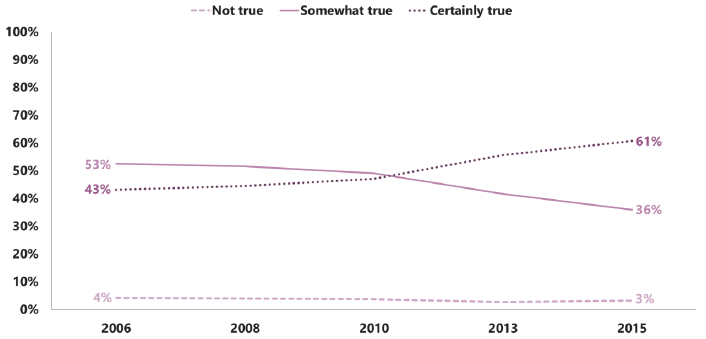
Base: See Appendix A
WEMWBS
While the SDQ measures emotional and behaviour problems, WEMWBS measures mental wellbeing - for example how good a pupil is feeling or how well they think they are coping in their life. In the WEMWBS scale, the lowest score possible (indicating poor mental wellbeing) is 14 and the highest is 70 (indicating good mental wellbeing), so a higher average score for any particular group indicates higher mental wellbeing.
The WEMWBS scale was only added to SALSUS in 2010, so there is not yet long-term trend data. Here we examine change between 2010 and 2015, although there has been little change in the WEMWBS scores in this time period.
The average [12] WEMWBS score for all pupils decreased slightly between 2010 and 2013 from 50.0 to 48.7. Between 2013 and 2015, there has been only a very minor decrease in the score to 48.4 which suggests that there have been no major shifts in mental wellbeing among 13 and 15 year olds.
For 13 and 15 year old boys, there has been little change in the average WEMWBS scores between 2013 and 2015 (from 51.3 in 2013 to 51.4 among 13 year old boys and from 50.2 to 50.1 among 15 year old boys). There has been a greater change in scores for 13 year old girls and 15 year old girls. 13 year old girl's mental wellbeing decreased from an average score of 48.7 to 48.2 and 15 year old girl's average WEMWBS score decreased from 45.1 to 44.4 (Figure 2.15).
Figure 2.15: WEMWBS average score, by age and gender (2010-2015)
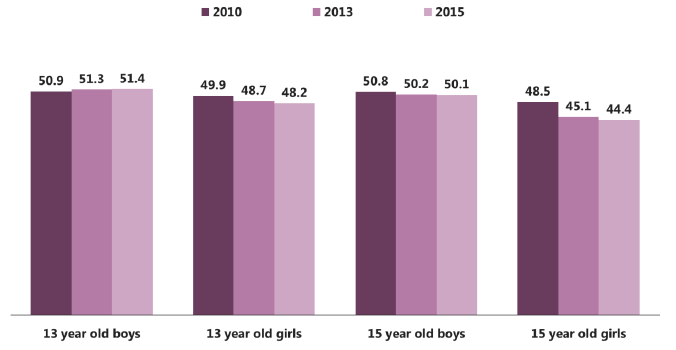
Base: See Appendix A
As there has been an overall reduction in mean score between 2010 and 2015 for 13 and 15 year old girls, the individual WEMWBS items were analysed in more detail to find out which had shown the greatest change during this time period.
The WEMWBS scale includes the following statements:
- I've been feeling optimistic about the future
- I've been feeling useful
- I've been feeling relaxed
- I've been feeling interested in other people
- I've had energy to spare
- I've been dealing with problems well
- I've been thinking clearly
- I've been feeling good about myself
- I've been feeling close to other people
- I've been feeling confident
- I've been able to make up my own mind about things
- I've been feeling loved
- I've been interested in new things
- I've been feeling cheerful
As expected given the difference in mean WEMWBS scores (Figure 2.15), 13 year old girls were more positive on each of the WEMWBS statements than 15 year old girls with the exception of 'I've been feeling interested in other people'.
Girls were most likely to say that they had been feeling loved (74% of 13 year olds and 63% of 15 year olds) and that they had been able to make up their mind about things (67% and 59%, respectively) (Figure 2.16 and 2.17).
Figure 2.16: Proportion of 13 year old girls who 'often' or 'all of the time' feel like… (2010-2015)
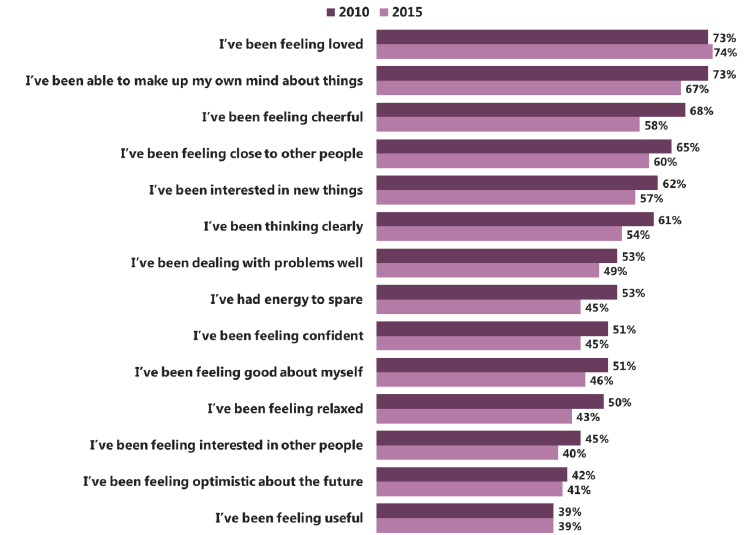
Base: See Appendix A
Between 2010 and 2015, the individual WEMWBS items that saw the greatest change among 13 year old girls were 'I've been feeling cheerful' (from 68% who said this was the case 'all of the time' or 'often' in 2010 to 58% in 2015), 'I've had energy to spare' (from 53% in 2010 to 48% in 2015) and 'I've been feeling relaxed' (from 50% in 2010 to 43% in 2013) (Figure 2.16).
Among 15 year old girls, a similar pattern emerged although to a greater degree. The greatest change was for 'I've been feeling cheerful' (from 61% who said this was the case 'all of the time' or 'often' in 2010 to 44% in 2015), 'I've had energy to spare' (from 43% in 2010 to 28% in 2015) and 'I've been feeling close to other people' (from 69% in 2010 to 55% in 2015) (Figure 2.17)
Figure 2.17: Proportion of 15 year old girls who 'often' or 'all of the time' feel that… (2010-2015)
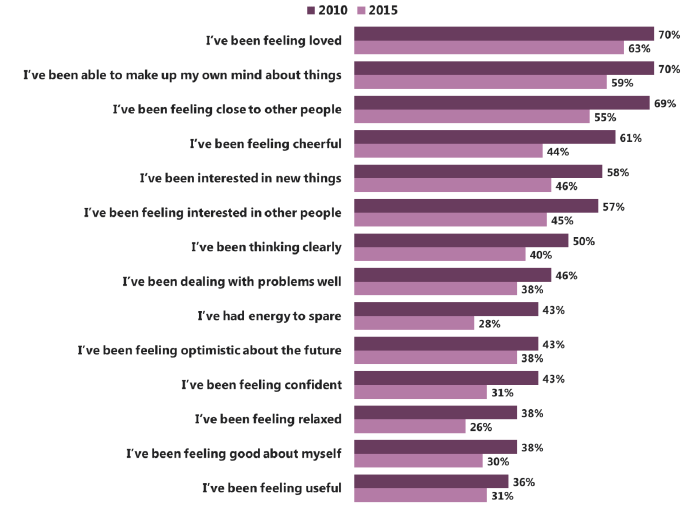
Base: See Appendix A
Contact
Email: Julie Guy
Phone: 0300 244 4000 – Central Enquiry Unit
The Scottish Government
St Andrew's House
Regent Road
Edinburgh
EH1 3DG
There is a problem
Thanks for your feedback